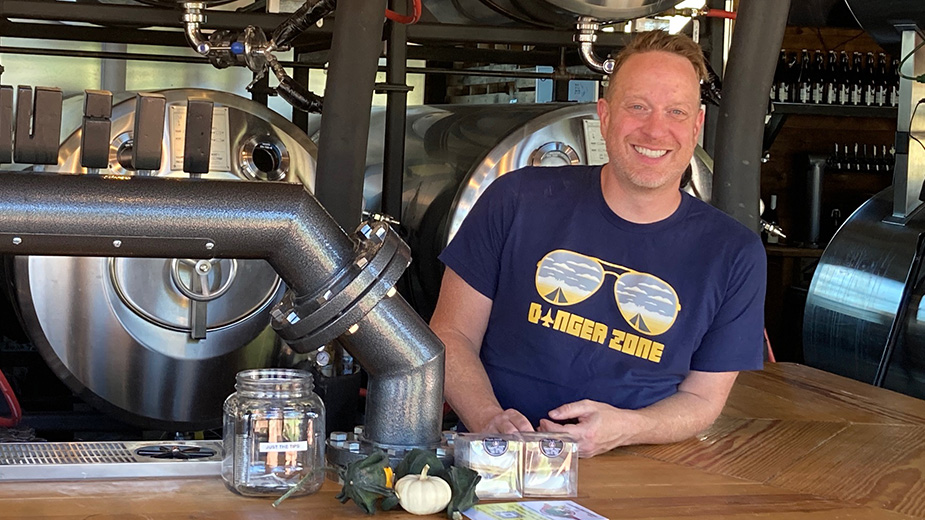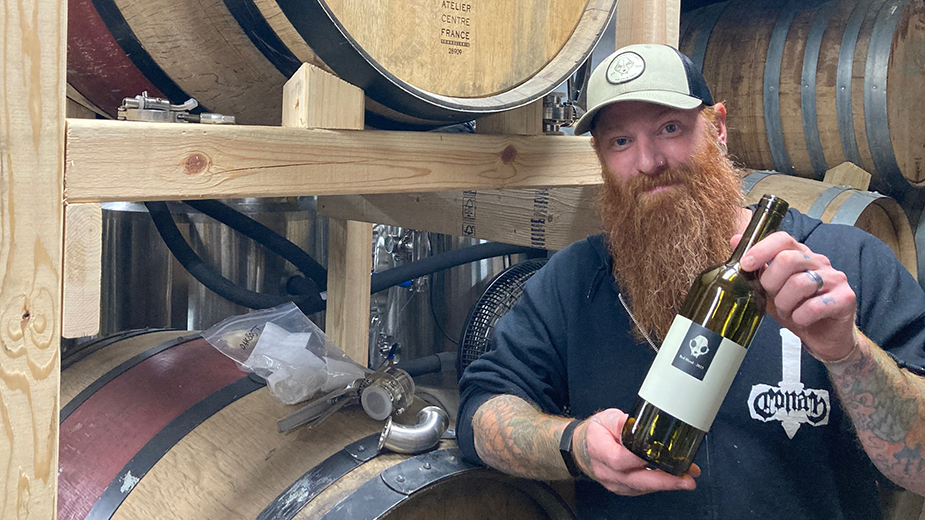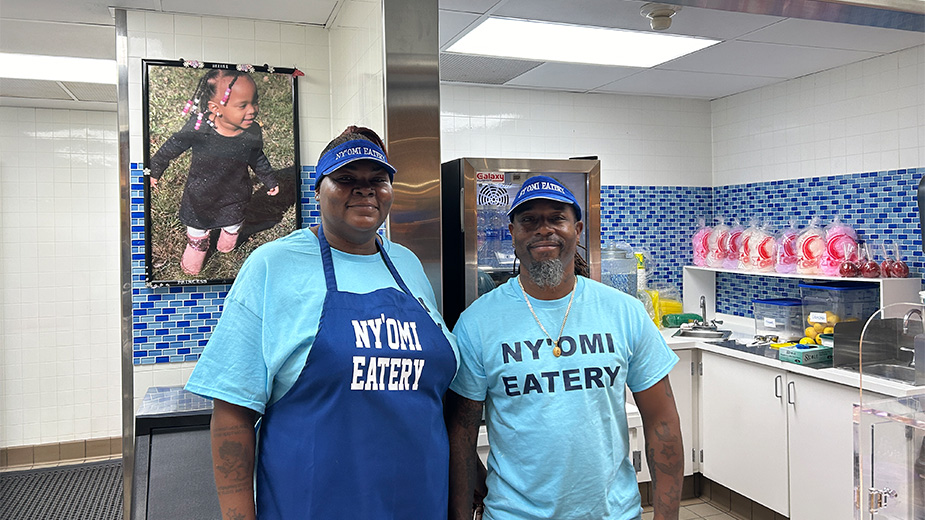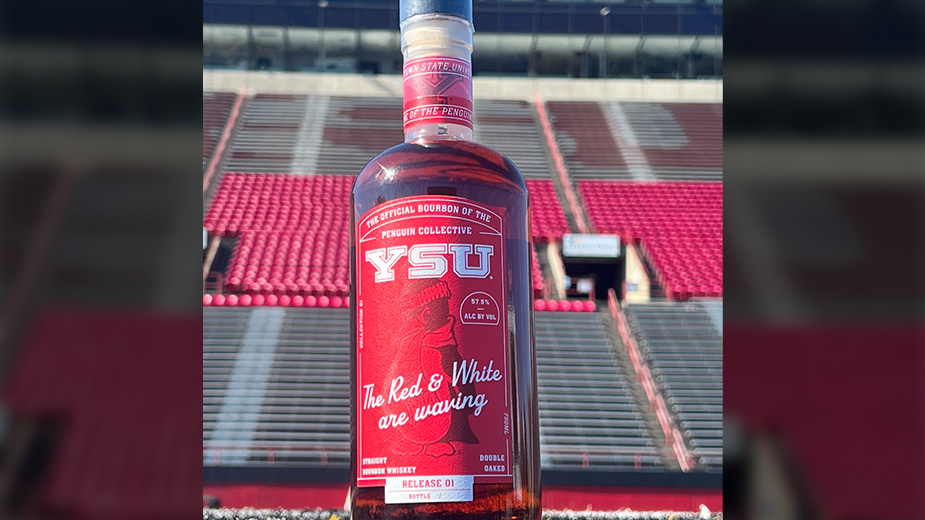Region’s Craft Breweries Tap Into Rapid Industry Growth
YOUNGSTOWN, Ohio – Barely a decade old, the regional craft brewing industry remains in its growth phase.
The 20 or so brewery-pubs in the five-county area continue to expand into distribution – although the day may not be too far off when their system capacities are maxed out.
From veterans like Birdfish and Paladin to newer brewers like Ill Will, they are becoming experts not only at making beer and running a pub, but in forecasting sales, ordering inventory and getting their products into bars and restaurants.
Growth of the local industry mirrors the rest of the country. According to Statista.com, there were roughly 9,100 craft breweries in the United States in 2021, accounting for 12.3% of total beer production volume.
The industry contributed $76.3 billion to the U.S. economy that year, according to BrewersAssociation.org, and 490,000 jobs.
Ohio ranked ninth among the states with 365 breweries (in 2011 it had 45), according to the website, while Pennsylvania ranked second with 486. (In 2011 it had 88). California ranks first with 931.
In terms of economic impact, craft breweries in Ohio contributed $3.1 billion in 2021, while those in Pennsylvania contributed $5.37 billion.
To see how and why the craft beer industry is growing locally, The Business Journal visited several new or noteworthy breweries.
BIRDFISH BREWING
Using 2021 figures, the leading Mahoning Valley brewer in production output is Birdfish Brewing in Columbiana. The company, which will mark its seventh anniversary this month, is also among the oldest and well established.
“Our production numbers are up,” says co-owner Josh Dunn. “We did about 800 barrels in 2019, 1,000 in 2020, and 1,300 in 2021.” His forecast for 2022 is also 1,300 barrels. Birdfish beer is sold in roughly 200 bars and restaurants in northeastern Ohio.
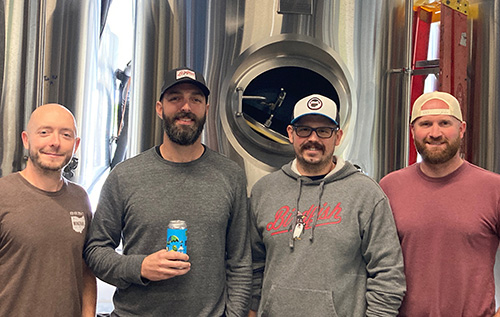
“The benefit of being a manufacturer with a taproom is flexibility,” Dunn says. “If on-site sales decrease like they did during the COVID years, you can increase your distribution. We had a lot of to-go and distribution sales during COVID. There was a big swing from 2019 to 2020 and then 2021. Now we are back to the point where taproom sales are the majority.
“We are where we were before COVID and maybe a little more because we added [the music venue] and more patio seating.”
Birdfish cans 50 to 300 cases per week, depending on the popularity of seasonal brews and in-house releases, says head brewer and co-owner Jared Channell. Dunn and Greg Snyder are the other co-owners.
The company has its own distribution department and delivers beer to bars as far away as the western suburbs of Cleveland. Its top seller, the IPA Too Hip to Sip, accounts for about 1,200 gallons a month, Dunn says.
With a very large patio that is tented and heated in the cold months, a spacious taproom, and a separate music venue with dozens of pinball machines, Birdfish is known for its atmosphere. It also has one of the best selections of merchandise, such as apparel.
Dunn says the popularity builds off Birdfish’s connection to the community. “We try to work with the community on [producing beer for special events], fundraisers and things that bring people together,” he says. “The atmosphere creates itself and we provide the space.”
Birdfish also supports local original music artists, regularly booking shows. “Our Saturday afternoon time slot is fun, family-friendly and dog-friendly,” he says.
The brewery draws “beer tourists” from Cleveland and Pittsburgh every weekend, he adds. “They travel for a pint and to pick up four-packs.”
Birdfish’s commitment to local extends to its ingredients. It gets its malted barley, or just “malt” – from Sam Yarian, a farmer just a few miles away in New Waterford.
Malt is the main ingredient in beer but hops and fruit are also commonly used as flavorings.
Birdfish gets a good percentage of its hops and all of its fruit from local growers.
“We have a beer in the tank with Niagara grapes from The Vineyards at Pine Lake called Juice Box,” Dunn says. Pine Lake is also just a few miles away.
The freshness of the local ingredients is discernible in the glass. “People realize its fresher,” Dunn says, explaining why with an example.
“Deschutes beer [an industry leader] is made in Oregon, shipped across the country, and sits in a warehouse. Taste that side by side against our Too Hip to Sip that was brewed a few days ago and kept cold.”
Yarian is a farmer who started his side company, Yarian Quality Malts, about five years ago. His first crop of barley was about five acres; he now plants up to 225 acres.
He sends his barley to a company near Cleveland for the malting process and then sells it to 10 local brewers.
Yarian also grows corn, soybeans and wheat but says the barley business is a lot more fun. “Agriculture-wise, it’s the same. But you get to see it go from its beginning to beer,” he says.
Most American barley is grown in Idaho and Washington state, but Yarian says Ohio has a good climate for it. “I was probably the first in the Mahoning Valley to grow barley for the craft beer industry,” he says.
PENGUIN CITY
With its rehabilitated building in downtown Youngstown that opened this summer, Penguin City Brewing Co. is poised to become the biggest producer in the area.
Co-owner Richie Bernacki says Penguin expects to produce a total of between 3,000 and 3,500 barrels for 2022. A barrel is 31 gallons. “Our goal is to hit 5,000 barrels in 2023,” he says. “After that, our system will reach its capacity.”
The company only recently brought all of its fermenting tanks online, both for distribution beers and its much smaller system for taproom-only beer.
Penguin City is unique in the area in that most of its beer is made for distribution, not on-premises consumption. Its products are sold in about 400 bars and restaurants.
The ratio of distribution to on-site sales is heavily lopsided toward distribution, Bernacki says. He lacked exact figures at hand but says the goal is to do even more distribution.
The company is making inroads into western Pennsylvania and the Pittsburgh market. It has a contract with one distributing company for eight counties and is looking into another for Mercer County, says co-owner Aspasia Lyras-Bernacki.
Penguin City currently handles its own distribution in Ohio but is looking to contract that segment out as well. “We want to expand our footprint,” Bernacki says. “Also, self-distribution is logistically challenging. Say I have to drive to Salem just to drop off two cases of beer. I might lose money on that trip because of labor costs and gas.”
The company has its own canning line. Sales fluctuate but it typically produces between 100 and 300 cases a week. The company uses 4,000 to 6,000 pounds of malted barley per month.
“We probably canned 300 cases a week in September because of our Oktoberfest beer,” Bernacki says. “It was our top-seller as soon as it was released.”
The Oktoberfest is a seasonal beer. Normally, Penguin City Light is the top-seller, followed by Penguin City Golden Ale. “We have about four barrels of Oktoberfest left” for on-site consumption, Bernacki says.
PALADIN BREWING
In previous years, most Penguin City Beer was brewed under contract by Paladin Brewing Co. of Austintown.
For years, that output pumped up Paladin’s production but it will drop sharply now.
John Chandler, owner and head brewer, doesn’t mind because it will let him focus on his own beer. He expects output to fall from about 1,500 barrels per year to a few hundred, with every drop being sold as Paladin.
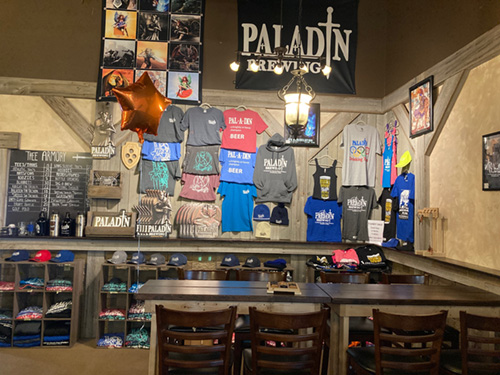
The company also previously brewed beer under contract for Numbers Brewing of Lisbon, CLE Brewing of Cleveland and Ohio Brewing, which began in Niles but is now in Columbus and Akron. The amount of beer brewed for other companies is reported to the Brewers Association by that company, and not the maker. Paladin no longer has any contracts with other brewers.
The brewery on Mahoning Avenue opened in 2015, making it one of the first brewpubs in the Mahoning Valley. Since then, it has built a base of about 80 bars and restaurants that sell Paladin on tap and in cans.
Chandler aims to see that number expand. His sales are now split evenly between on-site and distribution. “I would prefer it be 70% distribution, and 30% here,” he says.
Paladin has a theme of the Middle Ages, with knights and “Dungeons and Dragons”-inspired names for its beer and artwork.
Chandler added a kitchen about a year ago that offers flatbread pizza, wraps and pretzels. He also has 24 of his own beers on tap – by far the most of any area brewery.
His pub sales have grown tenfold over the years and that includes merchandise. Paladin has T-shirts, sweatshirts, hoodies and a blanket with a design that features its labels and posters.
The company label and merchandise art is exceptional, created exclusively by an artist in the eastern European country of Macedonia. “We have great artwork, and we want to showcase it,” Chandler says.
As for his beer, Paladin will now focus solely on its own products and aims to expand sales “until I need to hire more people,” Chandler says. “We’re deep into Columbiana County but we barely just touched Trumbull County. I’m going to keep making quality beer that people want to drink and focus more on marketing.”
ILL WILL BREWING
In 2019, Reader’s Digest declared Columbiana “the nicest place in America.” But the city might hold another title: America’s small-town beer-making capital.
Birdfish Brewing, The Vineyards at Pine Lake, BrewLounge Beer Company and Ill Will Brewing call Columbiana – population 6,500 – home. That’s one brewery for every 1,625 residents.
Asheville, N. C., is currently ranked No. 1 in the United States by RandMcnally.com for most breweries per capita. It has one brewery for every 3,359 residents.
Ill Will Brewing is Columbiana’s – and the area’s – newest brewery and will celebrate its first birthday this month.
It’s also one of the nicest and fastest growing, taking advantage of its location across from Firestone Farms Town Centre and the Links at Firestone Farms golf course.
It shares a courtyard and lawn with two AirBnB rental units that resemble 1800s houses and provide lodging for tourists on golf and other getaways. Harbel’s Farmers Market and the Firestone family museum are also on the property.
Brian Lalama, who co-owns the brewery with Ryan Gray and Kathy Schorejs, says Ill Will draws customers every week from Pittsburgh and Cleveland. “We are very seriously drawing from Pittsburgh and Cleveland,” Lalama says. “If you’re making an hour drive, you can stop at at least two locations when you get here. There is a buzz here.”
Like Birdfish, Ill Will also sources much of its ingredients locally. A farm directly behind the brewery produces a lot of the fruit and vegetables Ill Will uses. The brewery also grows a sizable percentage of its hops in a large garden just a few hundred feet away. “We hope to eventually get to full
self-sustainability,” Lalama says, including producing its own barley and wheat.
“We reverse-forecast,” he explains. “Instead of building a recipe and then trying to source the ingredients and be up against the supply chain, we start with what we can get that’s local and fresh and then decide on the recipe.”
The other main ingredient in beer, of course, is water, which also affects flavor. In the name of authenticity, Ill Will uses a reverse osmosis system to match the water used in beers brewed in Munich, Dublin or Pilsen in the Czech Republic, birthplace of the Pilsener style of beer.
“I will get the water report from Pilsen, replicate that water source, and brew beer from it,” Lalama says. “We wipe out the [Columbiana] city water and rebuild the water to replicate the city of its origin. We strive for authenticity. Our beer might taste different because we are using entirely different water.”
Ill Will has carved out a niche in what it calls smoothie beers. “They have a texture and are heavily fruited, like a smoothie,” Lalama says. “They are popular. And we always have three or four on tap.”
Recent offerings included apple-pear-cinnamon, pumpkin-vanilla, key lime-coconut, and cake batter. “They play like a dessert, but they are beer,” Lalama says. “They are for guests who don’t like beer.”
Ill Will isn’t stopping with smoothie beers. Up next will be barrel-aged beer, which take at least a year to ferment and will be ready next year. Barley wines and stout are also coming.
Perhaps Ill Will’s most interesting direction is its Project Mayhem beers. These are created by spontaneous fermentation – the original method that began before brewers understood that brewing was a chemical process.
“It’s thousands of years old,” Lalama says. “Brewers didn’t know yeast and bacteria were the catalyst for fermentation. They didn’t have microscopes and didn’t know that it was microscopic organisms doing this. They just left out sugar water and the natural yeast and bacteria floating in the air did the rest.”
Lalama and Gray wondered what might be floating in the air on the farm behind their property and decided to give spontaneous fermentation a try.
“It’s coming out sensationally,” Lalama says. “There are wonderful micro-organisms floating out here as far as beer making goes, which typically sour the beer.”
The Project Mayhem beers are aging in six wine barrels and will be bottled and released in the fall of 2023.
One thing in which Ill Will has no interest is distribution. It cans maybe three cases a week for to-go sales. Its beer is not sold in bars or restaurants.
“It’s not part of our immediate business plan,” Lalama says. “You take a substantial cut in margin to sell cans. Say a glass of beer costs 25 or 50 cents [to make] and sells for $5. You still have to sell a lot of it.
“But when you distribute, you can only sell it for $2.50 a glass so that [a restaurant or bar] can sell it for $5. But you have the same labor and costs.”
A large restaurant chain with outlets in Cleveland and Columbus approached Ill Will and wanted to buy 100 kegs of beer. It had to turn down the deal.
“It was enticing. But first of all, we don’t have 100 kegs,” Lalama says. “At $150 a keg, we’d have a $15,000 outlay just for kegs. Then I’d have to brew for two full days just to make enough. Then we’d need a vehicle. And it would take two days just to deliver them all. With gas and tolls, when you do all the math, it’s not worth it.”
Ill Will has ample space to expand and Lalama says perhaps one day it will get it into distribution. But for now, the owners are happy.
“There is something to staying at a level you can handle and still be profitable. Do you have to become a giant and kill yourself doing it?” he asks, with a laugh.
Top Local Brewers
Here are the top six regional brewers, according to data reported to the Brewers Association for 2021 (a barrel is 31 gallons):
1. Birdfish: 1,305 barrels
2. Penguin City: 800 barrels
3. Modern Methods: 500 barrels
4. Numbers: 355 barrels
5. Noble Creature: 274 barrels
6. Paladin: 224 barrels
Pictured at top: Brian Lalama, co-owner of Ill Will Brewing in Columbiana, stands behind the bar at the brewery pub.
Copyright 2024 The Business Journal, Youngstown, Ohio.
